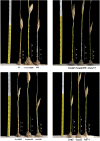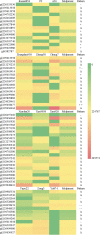Proteomic analysis reveals that auxin homeostasis influences the eighth internode length heterosis in maize (Zea mays)
- PMID: 29739966
- PMCID: PMC5940786
- DOI: 10.1038/s41598-018-23874-6
Proteomic analysis reveals that auxin homeostasis influences the eighth internode length heterosis in maize (Zea mays)
Abstract
Ear height is an important maize morphological trait that influences plant lodging resistance in the field, and is based on the number and length of internodes under the ear. To explore the effect of internodes on ear height, the internodes under the ear were analysed in four commercial hybrids (Jinsai6850, Zhengdan958, Xundan20, and Yuyu22) from different heterotic groups in China. The eighth internode, which is the third aboveground extended internode, exhibited high-parent or over high-parent heterosis and contributed considerably to ear height. Thus, the proteome of the eighth internode was examined. Sixty-six protein spots with >1.5-fold differences in accumulation (P < 0.05) among the four hybrids were identified by mass spectrometry and data analyses. Most of the differentially accumulated proteins exhibited additive accumulation patterns, but with epistatic effects on heterosis performance. Proteins involved in phenylpropanoid and benzoxazinoid metabolic pathways were observed to influence indole-3-acetic acid biosynthesis and polar auxin transport during internode development. Moreover, indole-3-acetic acid content was positively correlated with the eighth internode length, but negatively correlated with the extent of the heterosis of the eighth internode length.
Conflict of interest statement
The authors declare no competing interests.
Figures








Similar articles
-
Comparative transcriptomic analysis of maize ear heterosis during the inflorescence meristem differentiation stage.BMC Plant Biol. 2022 Jul 18;22(1):348. doi: 10.1186/s12870-022-03695-6. BMC Plant Biol. 2022. PMID: 35843937 Free PMC article.
-
Investigating the molecular genetic basis of heterosis for internode expansion in maize by microRNA transcriptomic deep sequencing.Funct Integr Genomics. 2015 May;15(3):261-70. doi: 10.1007/s10142-014-0411-2. Epub 2014 Nov 14. Funct Integr Genomics. 2015. PMID: 25394807
-
Comparative proteomic analysis reveals that the Heterosis of two maize hybrids is related to enhancement of stress response and photosynthesis respectively.BMC Plant Biol. 2021 Jan 9;21(1):34. doi: 10.1186/s12870-020-02806-5. BMC Plant Biol. 2021. PMID: 33422018 Free PMC article.
-
Allelic variation and heterosis in maize: how do two halves make more than a whole?Genome Res. 2007 Mar;17(3):264-75. doi: 10.1101/gr.5347007. Epub 2007 Jan 25. Genome Res. 2007. PMID: 17255553 Review.
-
Biochemical analyses of inbreds and their heterotic hybrids in maize.Prog Clin Biol Res. 1990;344:639-64. Prog Clin Biol Res. 1990. PMID: 2203058 Review.
Cited by
-
Comparative proteomic analysis provides new insights into the specialization of shoots and stolons in bermudagrass (Cynodon dactylon L.).BMC Genomics. 2019 Sep 11;20(1):708. doi: 10.1186/s12864-019-6077-3. BMC Genomics. 2019. PMID: 31510936 Free PMC article.
-
Combating Dual Challenges in Maize Under High Planting Density: Stem Lodging and Kernel Abortion.Front Plant Sci. 2021 Nov 2;12:699085. doi: 10.3389/fpls.2021.699085. eCollection 2021. Front Plant Sci. 2021. PMID: 34868101 Free PMC article. Review.
-
Proteomic analysis of heterotic seed germination in maize using F1 hybrid DHM 117 and its parental inbreds.Turk J Biol. 2018 Aug 9;42(4):345-363. doi: 10.3906/biy-1803-13. eCollection 2018. Turk J Biol. 2018. PMID: 30814898 Free PMC article.
-
Genome-wide haplotype-based association analysis of key traits of plant lodging and architecture of maize identifies major determinants for leaf angle: hapLA4.PLoS One. 2019 Mar 6;14(3):e0212925. doi: 10.1371/journal.pone.0212925. eCollection 2019. PLoS One. 2019. PMID: 30840677 Free PMC article.
-
Auxin perception in Agave is dependent on the species' Auxin Response Factors.Sci Rep. 2020 Mar 2;10(1):3860. doi: 10.1038/s41598-020-60865-y. Sci Rep. 2020. PMID: 32123284 Free PMC article.
References
Publication types
MeSH terms
Substances
LinkOut - more resources
Full Text Sources
Other Literature Sources

